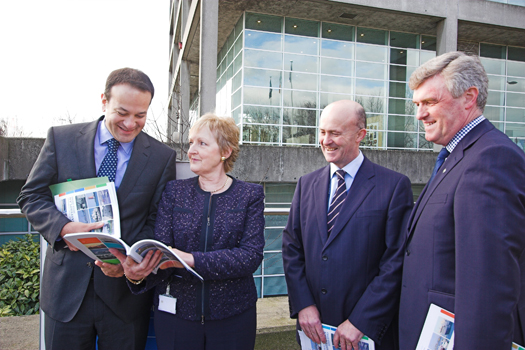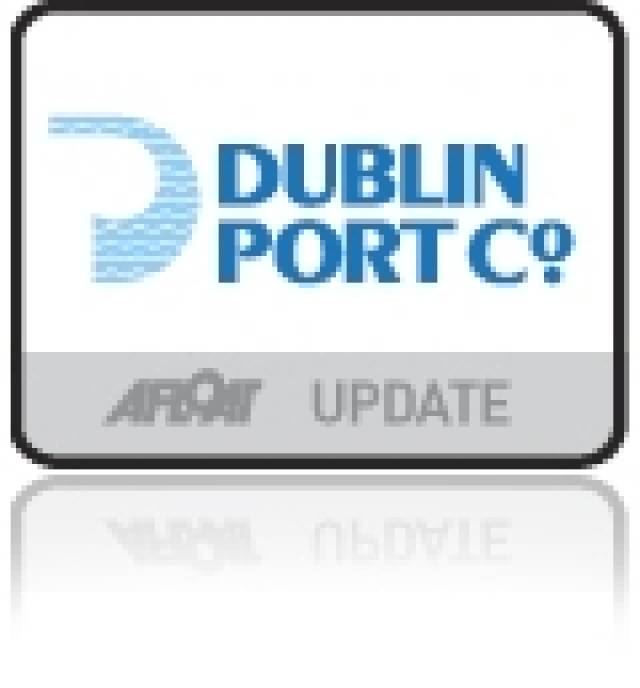#DUBLIN PORT–Dublin Port Company will invest €110m from its own reserves over next five years in the Capital's port it was announced this morning when a long term master plan was unveiled. The final Masterplan is available for download below.
Port Chief Executive Eamon O'Reilly says the size of the port will remain the same for the next 10 years, but after that, expansion will be needed.
"We reckon we have enough of a footprint at the moment to last us for growth for about a decade or maybe even a bit more than that," Mr O'Reilly told the Irish Examiner.
Minister for Transport, Tourism and Sport Leo Vradkar launched Dublin Port Company's Masterplan 2012 to 2040 today. The plan sets out the framework for the long-term development of Ireland's largest and most important port. Implementing the plan will cost in excess of €600m over the next 30 years which will be financed from the company's own resources.
Dublin Port Company has already committed to investing €110m over the first five years of the Masterplan period.
The launch of the Masterplan follows a year-long consultation with business, community, industry and government stakeholders.

Launching Dublin Port Company's Masterplan 2012-2040, a framework for the long-term development of Dublin Port which will be financed from the company's own resources, were Minister for Transport, Mr. Leo Varadkar T.D., Mr. Eamonn O'Reilly, Chief Executive of Dublin Port Company, Ms. Lucy McCaffrey, Chairperson of Dublin Port Company and Dublin City Manager, Dr. John Tierney
Central to the Masterplan is ensuring Dublin Port's capacity to service Ireland's future import and export trading needs both efficiently and competitively. The Masterplan now provides Dublin Port Company and its stakeholders with a clear view as to how the port will be developed over the long-term.
In economic terms, it will mean Dublin Port Company will be ready to handle 60 million tonnes of goods by 2040, double its current throughput based on a modest assumed growth of 2.5% per annum.
The Masterplan is founded on three principles:
· Maximising the use of existing lands;
· Reintegrating the port with the city; and
· Developing the port to the highest environmental standards.
The Masterplan has clearly shown that Dublin Port will need to expand over the next 30 years. However, the port has some breathing space because of the economic downturn and can now cater for projected growth for a decade or more within its existing footprint. The initial investment under the Masterplan will be focussed on maximising the use of the port's existing capacity. Projects involving reclamation will only be advanced if and when they become necessary and if they can meet exacting planning and environmental protection standards.
Among the first projects that Dublin Port Company has identified to achieve its aims is the building of a dedicated car storage compound on a site between East Wall Road and the Dublin Port Tunnel. This facility would free up valuable quay-side space for port activity.
Another major initiative is the construction of a new cruise facility adjacent to the east of the East Link Bridge to accommodate over 135,000 passengers and almost 90 cruise liners each season. The company believes that the option identified in Dublin City Council's Cruise Tourism Local Action Plan of the North Quay extension would provide the optimum location for this, bringing high spending passengers and crew within easy reach of the Luas and city centre shops, eateries and attractions.
To progress this concept, Dublin Port Company has formed Cruise Dublin, a joint initiative with Dublin City Council and Dublin Chamber of Commerce aimed at further developing the cruise tourism trade in Dublin. The first step will be to undertake a study of the needs of the cruise industry and to learn from best practice elsewhere how a suitable cruise terminal can be provided in Dublin. The estimated cost of the development is €30 million. This study will be concluded later this year with a view to having a cruise terminal in place by 2015.
Integrating Dublin Port with Dublin city and its citizens is another core aim of the plan. In that context, improved walkways and cycle paths, public viewing platforms, the installation of maritime art displays and softer port boundaries are among the initiatives intended to bring real community gain. The plan also envisages the development of a visitor centre which could include: displays of archive materials; old equipment used in the port; video displays of port operations and interactive features such as simulated crane operating and piloting a vessel safely into the port.
The Masterplan has also identified the potential for rail freight to grow over the next 30 years using Dublin Port's direct rail connections to all major train stations in Ireland. The use of the existing port rail network already removes 4,000 trucks from Irish roads every year and there is significant scope to increase this.
The development of a dedicated port distribution centre under the Masterplan would provide a hub for smaller, greener vehicles to service the city's businesses in a greener, more efficient way.
Launching Dublin Port Company's Masterplan, Leo Varadkar, TD, Minister for Transport, Tourism and Sport said; "This is a comprehensive plan for the long-term development of Dublin Port on its current site. As Ireland's most important port, Dublin Port is a vital part of our national infrastructure. It has a significant role to play in growing exports, growing jobs, and also in growing tourism, with 87 cruise ships calling last year. This Masterplan follows a detailed consultation process and will ensure that Dublin Port continues to make a real contribution to the local economy, and to our export-led recovery."
Lucy McCaffrey, Chairperson of Dublin Port Company, said: "While the impetus for producing this Masterplan has been to provide Dublin Port Company and all its stakeholders with a clear view as to how Dublin Port will develop over the next 30 years, we have endeavoured to strike a balance between the economic needs of the city and improving the aesthetics of the port and better integrating it with the city. We look forward to embarking on a range of initiatives to bring this commitment and the Masterplan to life in local communities. Our plan also envisages the development of a visitor centre which will show Dubliners the history of the port and provide an insight into its workings in an innovative and interactive way."
Eamonn O'Reilly, Chief Executive of Dublin Port Company, said: "This is an exciting time in the development of Dublin Port. For the past year we've consulted extensively to get to the position today where we can unveil our Masterplan for the development of Dublin Port over the next 30 years. The projects identified under this plan will be advanced in stages based on capacity, economic demand and our ability to finance them. The fact that we're committing to a €110 million investment programme over the next five years shows our intent to implement the Masterplan. It is worth noting also that under the Masterplan, Dublin Port Company has committed to continuing to develop Dublin Port within its current footprint to the maximum extent possible before considering projects involving major land reclamation. Any projects from the Masterplan will be subject to the existing planning processes."
Welcoming the Masterplan, John Tierney, City Manager, said: "Dublin Port has always been a key part of Dublin city's economic infrastructure, facilitating trade and supporting jobs in the capital. It's hugely important that the appropriate facilities and infrastructure are in place at Dublin Port as the city looks to future growth and development both from a trade and tourism perspective. In particular, the launch today of Cruise Dublin shows how Dublin Port Company is working with Dublin City Council and others to develop the hugely valuable cruise tourism trade even further. Work is already underway to assess the feasibility of constructing a dedicated €30 million cruise terminal in Dublin Port by 2015."
The final Masterplan is available for download below































































